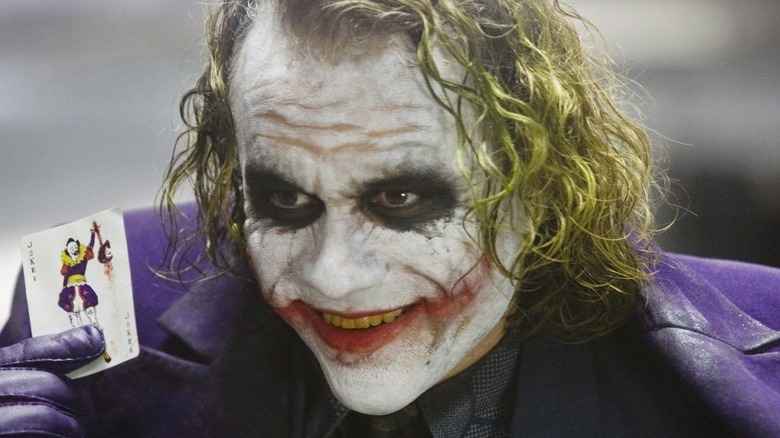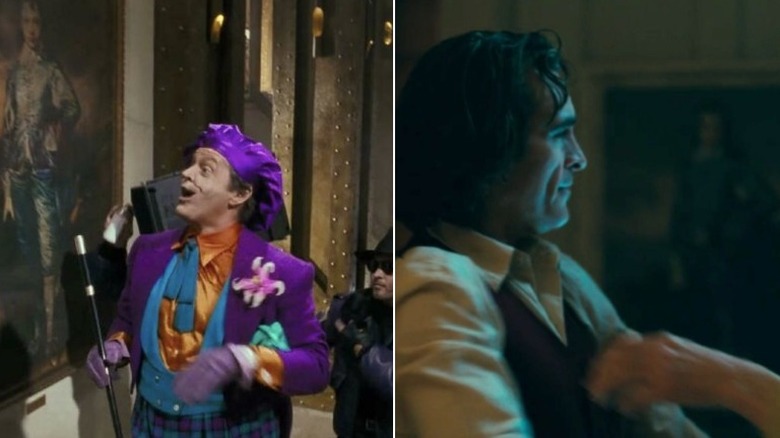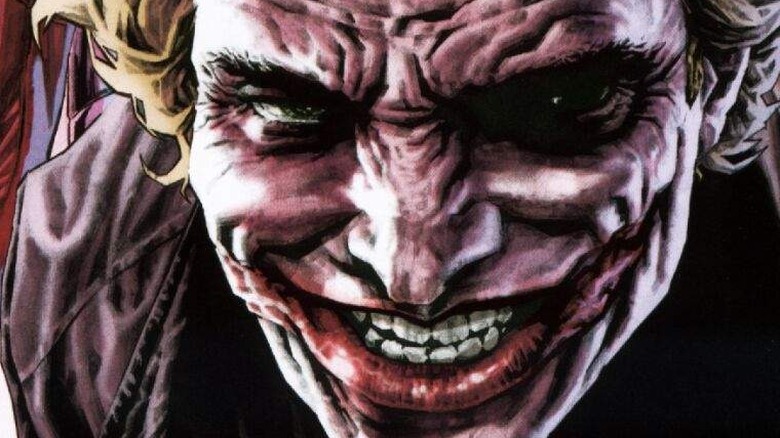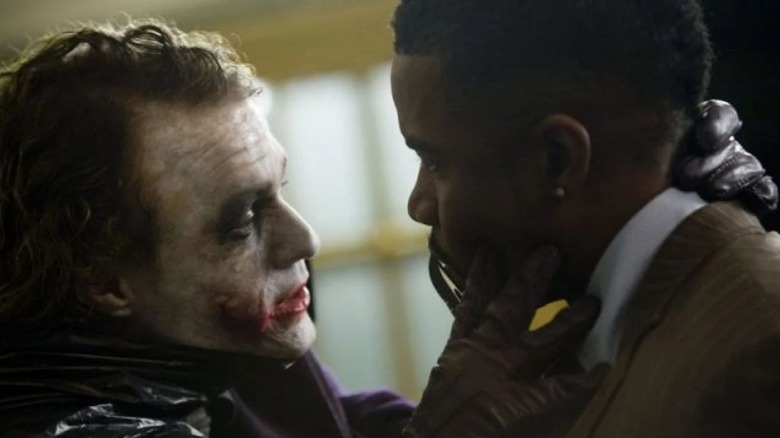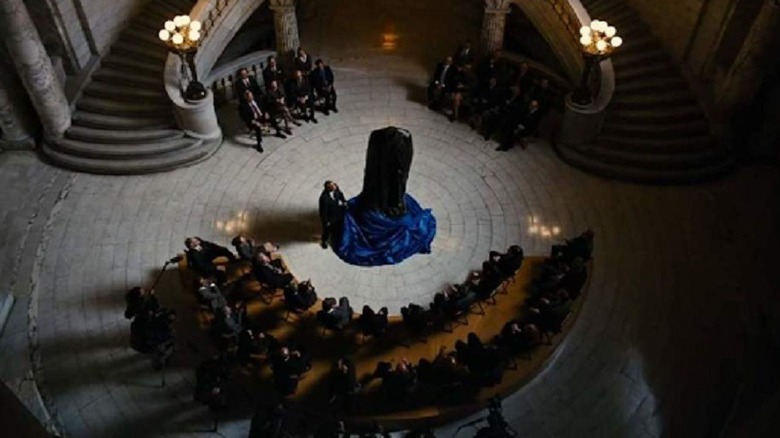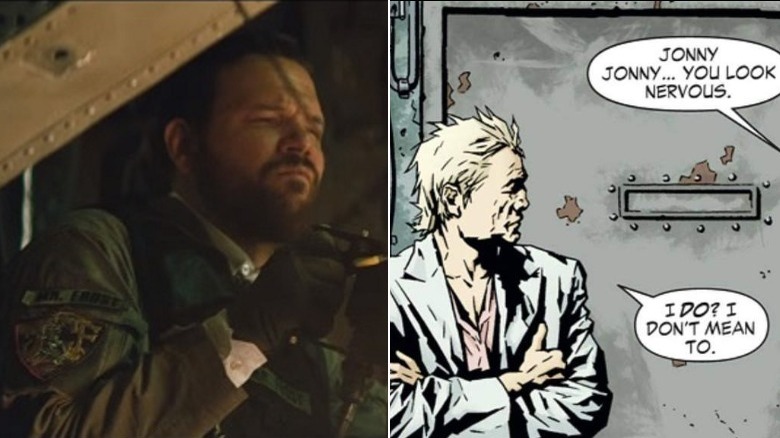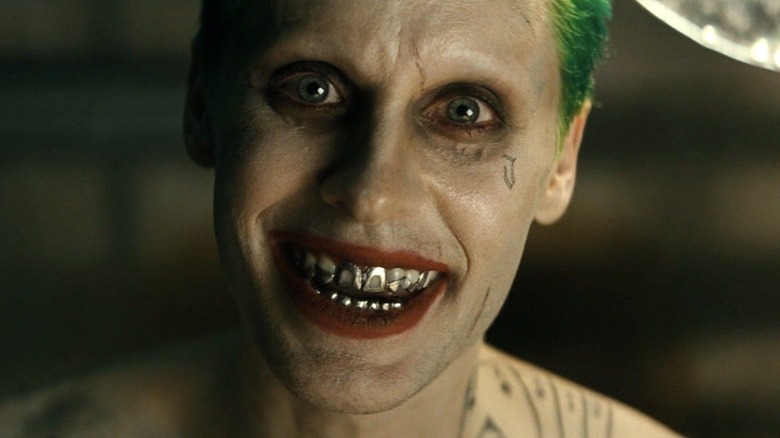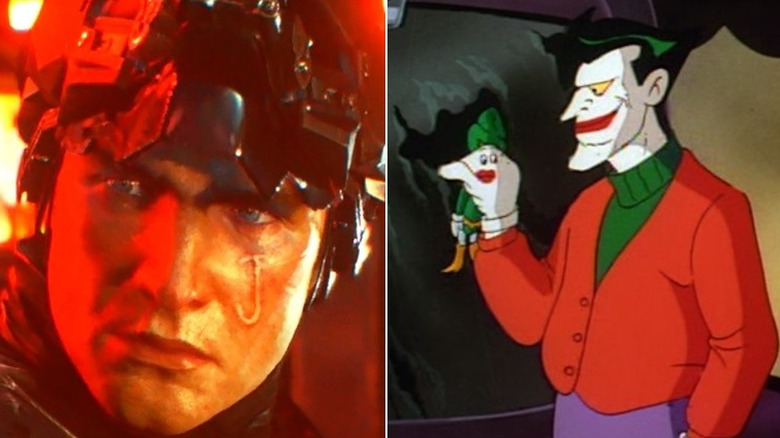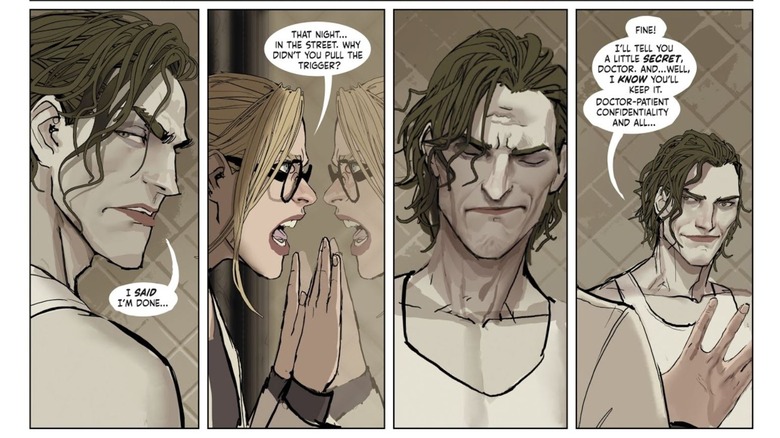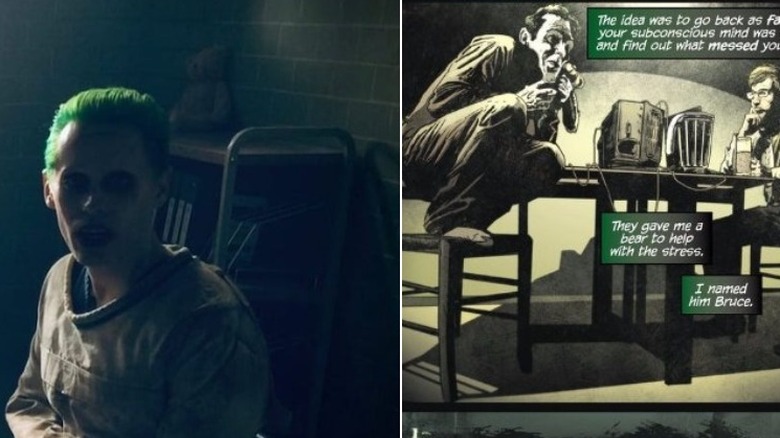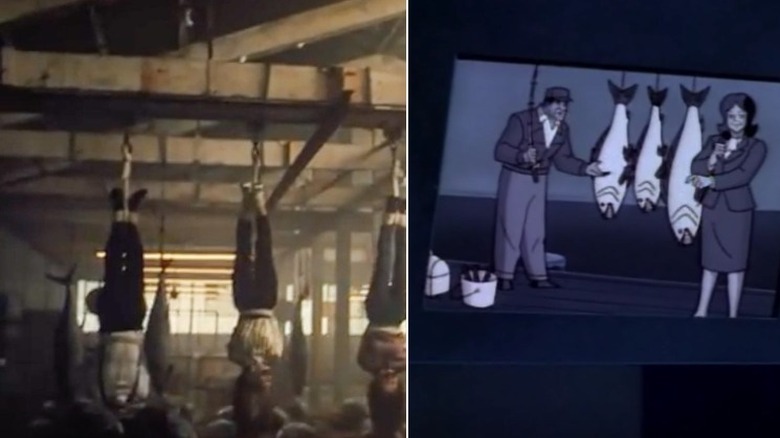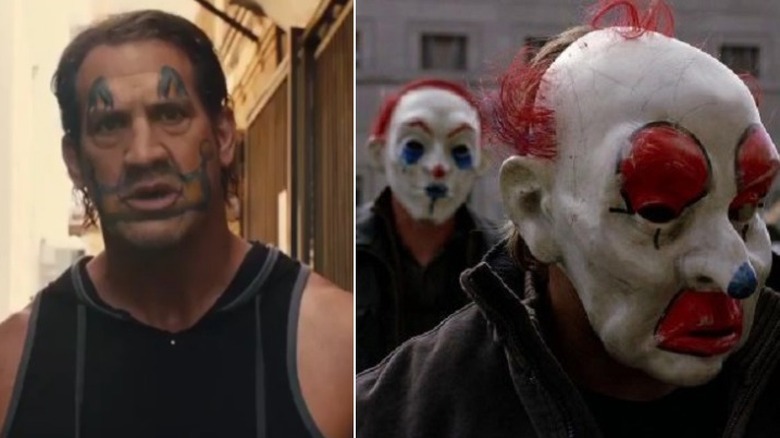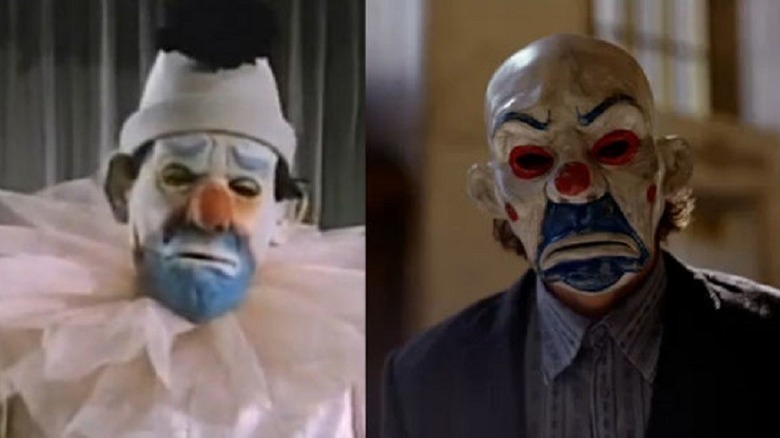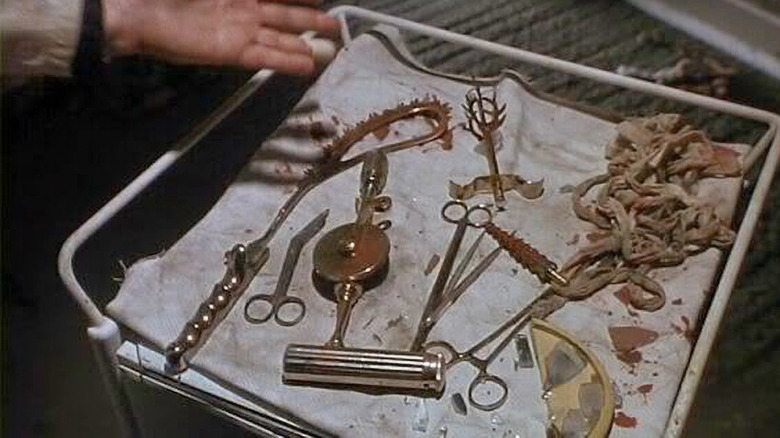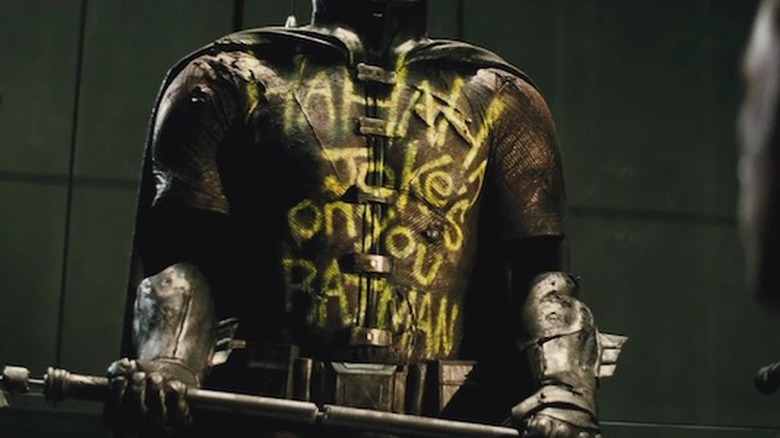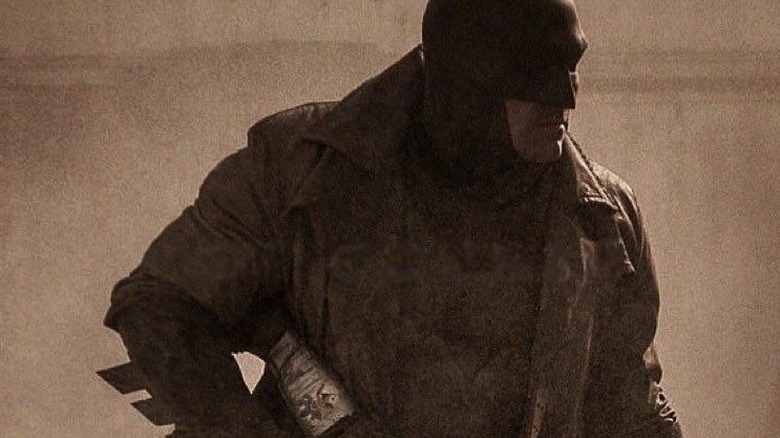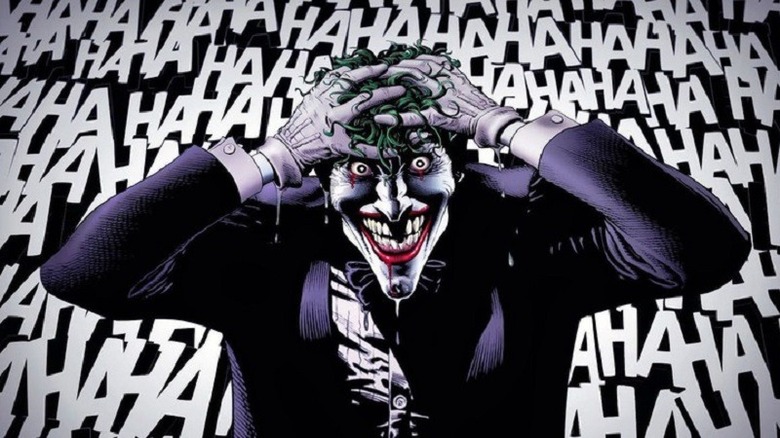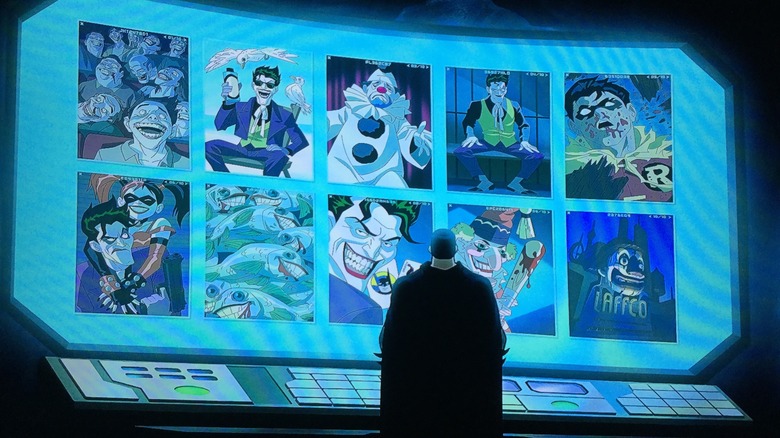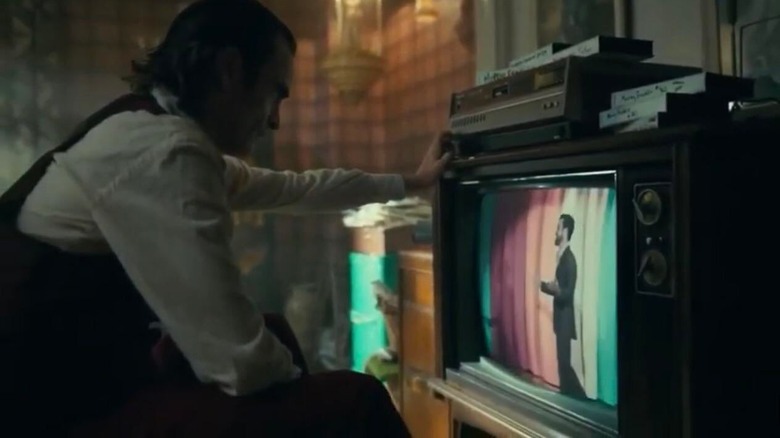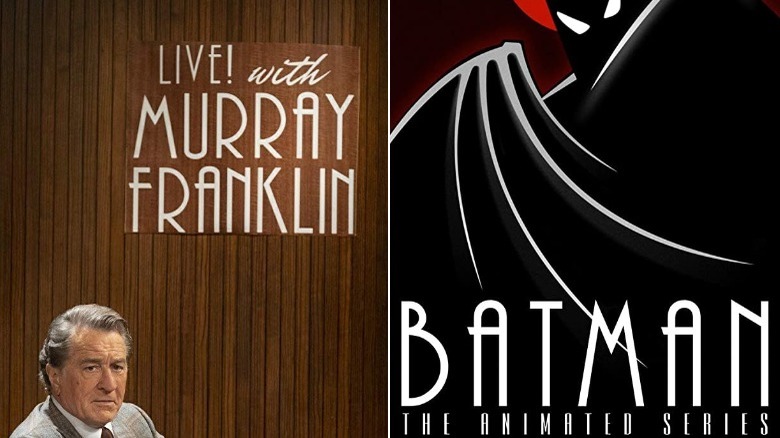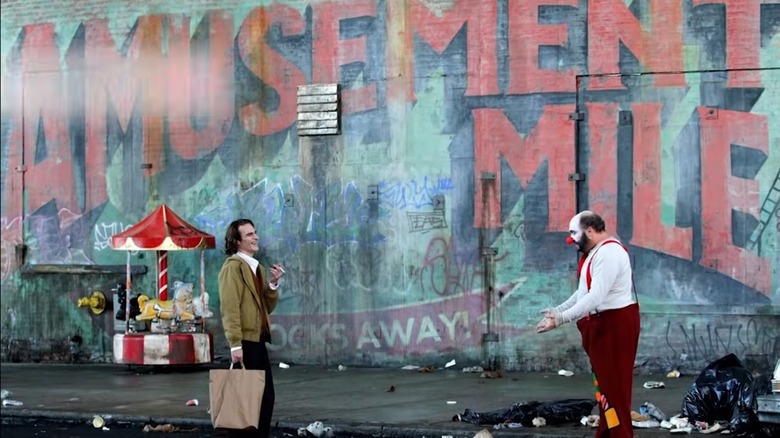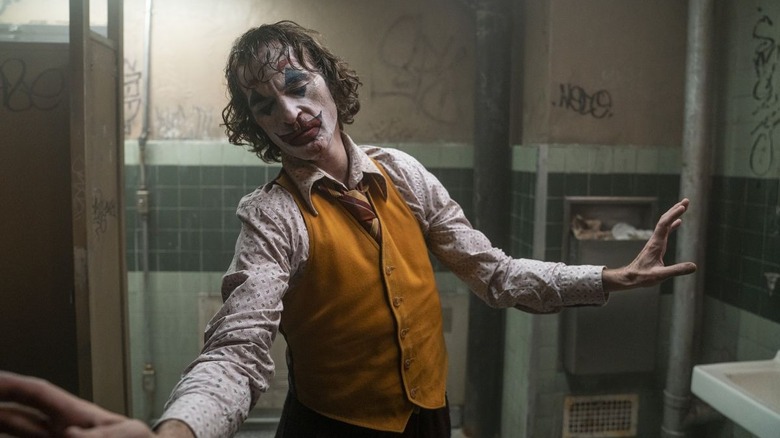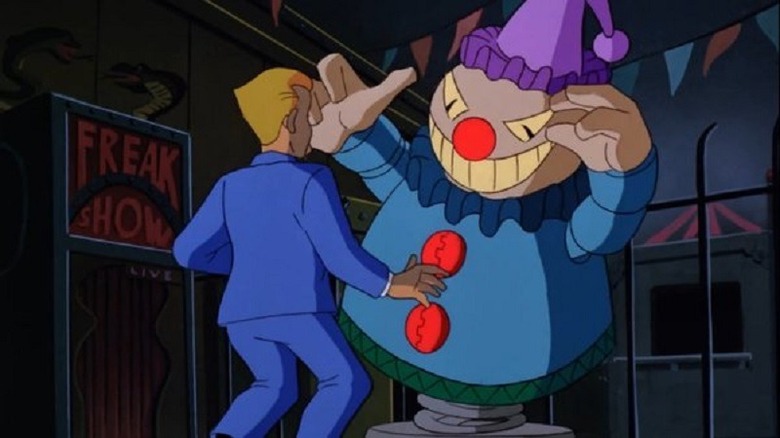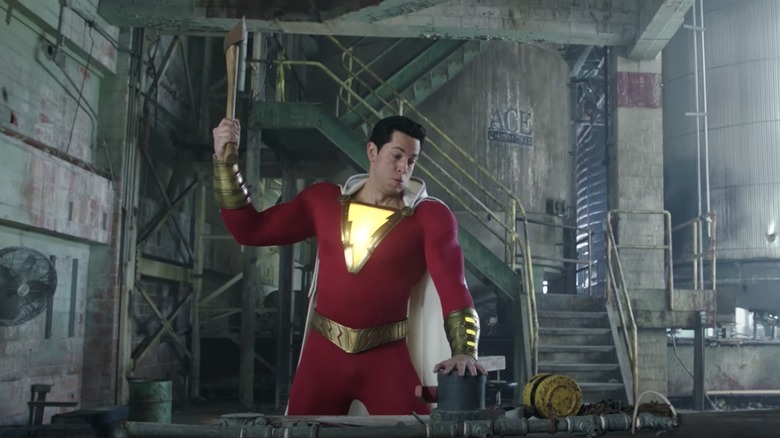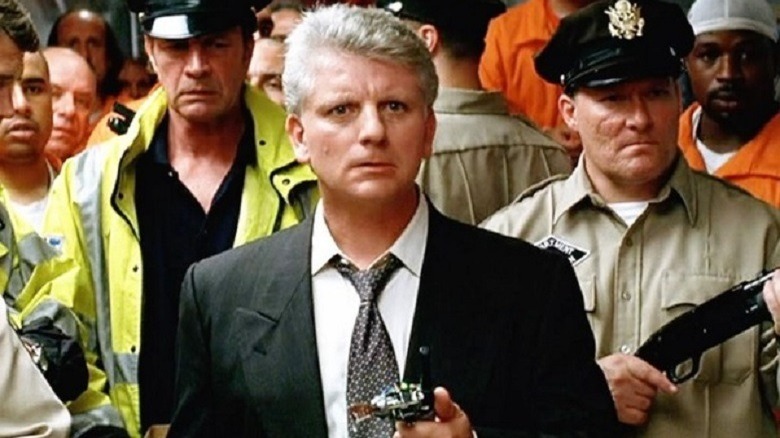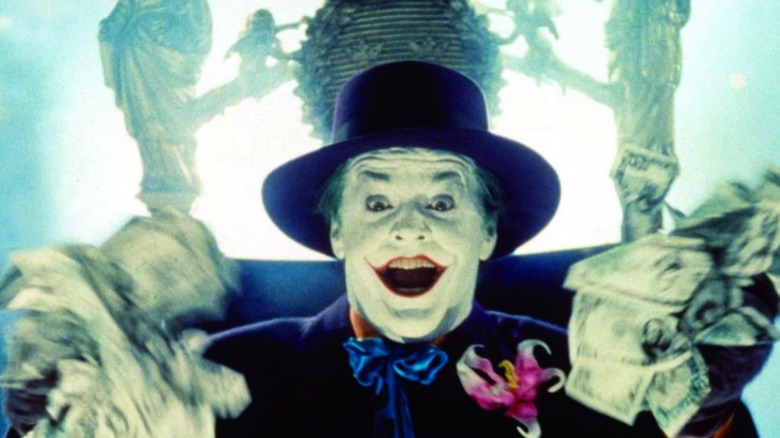The 26 Best Joker Easter Eggs Of All Time
For decades, the Joker has captivated and horrified comic book readers, cinephiles, and gamers around the globe. Batman's nemesis complements the hero flawlessly, encapsulating the eternal struggle of good versus evil. Ironically, in this case, the man in black is the good guy, while his colorful counterpart is one of the most brutal villains ever to grace the four-colored page.
As the wild card in the deck of Batman's enemies, the Joker can be reimagined over and over again to fit the needs of the cultural zeitgeist. Various artists, writers, directors, and actors have contributed their own personal visions of the Joker to this modern mythos. These many different portrayals often reference each other through creatively planted Easter eggs. Once you start looking for references to the Joker and his history, in fact, you'll find them all over DC productions of all stripes. From obscure references in graphic novels to the sly reuse of memorable props to cleverly recycled character lines, these are the greatest Joker Easter eggs around.
A painting with a colorful past
Sharp-eyed fans have noticed the repeated use of a specific painting in films featuring Joker: Thomas Gainsborough's "The Blue Boy." The 1770 portrait captured the public's attention in 1921 when railroad mogul Henry E. Huntington bought it for the staggering sum of $729,000. Since then, "The Blue Boy" has come to represent both mastery of artistic expression and indulgent pretense. This inherent double meaning makes it a popular Hollywood prop.
For more than a century, "The Blue Boy" has influenced storylines, sets, and character designs in film. Its legacy can be glimpsed in silent cinema, Shirley Temple films, "Django Unchained," and "Austin Powers." "The Blue Boy" and the Joker go way back: Cesar Romero references the painting in an episode of the classic "Batman" TV series, Jack Nicholson defaces the painting in 1989's "Batman," and a copy of the portrait hangs on the wall of Arthur Fleck's apartment in 2019's "Joker."
Lee Bermejo's Joker
When "The Dark Knight" hit theaters in 2008, avid DC Comics fans couldn't help but notice uncanny similarities between Heath Ledger's look and the unique style of artist Lee Bermejo. Bermejo's eerily realistic portrayals of the Joker began in 2005, as exclusive art for the Batman on Film website. A few years later, Bermejo's vision was fully realized in the pages of the haunting 2008 graphic novel "Joker," a collaboration between Bermejo and writer Brian Azzarello. The book hit shelves just a few months after "The Dark Knight" was released, which caused many to assume Bermejo looked to Ledger's Joker in creating his take on the villainous clown.
This is untrue, though it's not surprising so many fans believe it: When comparing the two Jokers side by side, their similarities certainly stand out. But, as Bermejo clarified to IGN, this was a coincidence. "Certain ideas float around at the same time for a reason," Bermejo noted. "If you want to do a realistic interpretation of the Joker, there are only a few ways to do it." One wonders, could Nolan have looked to Bermejo's Joker for inspiration? No one knows for sure, but it definitely doesn't seem impossible.
Spawn insults the Joker
It's never wise to cross the Clown Prince of Crime, as many unfortunate souls have learned the hard way. Michael Jai White's character in "The Dark Knight," Gotham mob boss Gambol, joins these ranks after getting fed up with the Joker's antics. While proposing Gotham's criminals pool their efforts to kill Batman once and for all, Gambol interrupts the Joker by yelling, "Enough from the clown!"
Believe it or not, White had already delivered this very line. 11 years prior to his "Dark Knight" performance, White dismissed clowns as the titular star of 1997's "Spawn." After returning from the dead, the man formerly known as Al Simmons finds himself transformed into a reluctant soldier of Hell. To make matters worse, he also has to tolerate an incredibly creepy and disgusting mentor in Violator, a demented clown. It is at Violator that Spawn hollers the line in question, in an extreme moment of frustration.
Seeing the Joker's face in the crowd
As Heath Ledger's Joker casts a gigantic shadow, it can be easy to forget that he's only actually in one film. However, perceptive viewers might note an eloquent homage to the late actor during the culmination of the final film in Christopher Nolan's trilogy.
During the last few minutes of "The Dark Knight Rises," all of Gotham mourns the assumed loss of their beloved hero, Batman. As a way to pay tribute, a memorial is held and a giant statue is erected in his honor. While the unveiling ceremony takes place, the camera pans up to capture a shot of the statue and crowd.
When seen from above, the clusters of black-clad onlookers centered around the cloth-swathed Batman statue strongly resemble a clown's face. In fact, the assemblage kind of looks like the blue and red clown mask donned by the Joker while committing the bank robbery at the beginning of "The Dark Knight."
A Joker henchman with a complex past
The Joker has had many henchmen in his ranks over the years, but sadly, few live long enough to have tales of their own. One of the rare exceptions to this morbid rule is Jonny Frost, a lackey who also happens to be a point-of-view character in Brian Azzarello and Lee Bermejo's "Joker." Frost's experiences at the Joker's side are twisted, to say the least: The Frost who bids the reader farewell in the graphic novel's final pages is a very different man than the Frost who begins the tale by picking the Joker up from Arkham Asylum.
Although he's never directly named, Frost makes an appearance as the Joker's henchman in 2016's "Suicide Squad," played by Jim Parrack. Those with quick eyes can identify him during the helicopter scene by a patch on his jacket sleeve reading "Mr. Frost." Director David Ayer acknowledged the Easter egg on Twitter, stating, "Azzarello was a major influence."
Joker's shiny new grill
One of the most notable Easter eggs in "Suicide Squad" involves the Joker's shiny metal teeth. Most fans interpret the Joker's grill as simply being part of his bling-centric reinvention. In fact, the Joker's dazzling dentistry is a major nod to an infamous comics moment.
Director David Ayer clarified in 2016 that every detail of the Joker's look has a backstory. "And even his teeth," he detailed, "there's an entire story behind that, which is absolutely canon." Some fans assumed he was referring to "Birds of Prey" #124, in which Barbara Gordon smashes Joker's teeth in as payback for shooting her in "The Killing Joke." In fact, Ayer explained via Twitter that it was Batman who smashed the Joker's teeth in, "for killing Jason Todd."
This reference does indeed have roots in DC canon: Killing Jason Todd, the second Robin, is one of the worst things the Joker has ever done. In "Batman" #496, Batman is doused with Scarecrow's fear toxin, and subsequently finds himself immersed in visions of Todd's agonizing end. Enraged, Batman finds the Joker and beats him to a bloody pulp. Perhaps this is the very fight Ayer was thinking of when he gave the Joker his grill.
Joker's tattoos tell a story
Whether you love them or hate them, the tattoos Jared Leto's Joker sports are a ripe hunting ground for Easter eggs. In fact, Ayer has explained that Joker's tattoos are a way of putting his "history on his body."
For one thing, the "J" tattooed on Joker's cheek is highly reminiscent of a pivotal moment during a boss fight in "Batman: Arkham Knight." A dramatic reveal shows the assumed-to-be-dead Jason Todd is, in fact, alive and ... not well. In fact, he's been twisted by the Joker's abuse and lies. One of these deceits saw the Joker brand Jason's cheek with a "J," and convince him Batman did it instead.
The smile tattoo on Joker's left hand brings to mind the Joker's first appearance on "Batman: The Animated Series." In "Christmas with the Joker," the Clown Prince of Crime hijacks Christmas Eve as only he can, complete with explosives, giant nutcrackers, and a maniacal hand puppet elf dubbed "Laffy," whose lipstick smile is more than a little reminiscent of Leto's hand tattoo.
The Joker's secret
One of the greatest things to come out of "Suicide Squad" is Margot Robbie's Harley Quinn, who is covered in Joker-centric tattoos. On one of Harley's legs reads the phrase, "Let me tell you a sekret." This brings to mind an important turning point in Harley's relationship with the Joker, captured in Stjepan Šejić's "Harleen" series.
Years before she was a famed criminal, Harley Quinn was Dr. Quinzel, a psychiatrist conducting research at Arkham Asylum. In "Harleen," Dr. Quinzel finds herself becoming intimate with the Joker, despite how crazy she knows it is to do so. When she asks him why he didn't kill her when they randomly crossed paths during one of his prior crime sprees, he replies with unexpected candor. "I'll tell you a little secret doctor," he says. "I thought, I wouldn't mind seeing her smile." That's definitely the kind of memory Harley would want to immortalize in her own skin.
Joker's therapy teddy
As originally noted by an eagle-eyed fan on Twitter, an excellent comic book Easter egg can be spotted lurking in the background of "Suicide Squad:" The Joker's teddy bear! It seems even the toughest homicidal maniacs can have a soft spot for cute, fuzzy animals.
This adorable plushie has been spotted in a couple of different tales set in Arkham Asylum. It's hard to imagine Joker caring about anything or anyone besides himself, but apparently this homicidal maniac is very attached to his teddy bear.
Not only is Joker fond of the plush, he even names him "Bruce" in the "Reality Check" chapter of "Batman 80-Page Giant 2010." This hints at the fact that the Joker likely knows Batman's true identity. Naturally, he still loves to treat such a valuable piece of information irreverently. Pity poor Bruce the teddy bear: Lord only knows what things he's seen.
Something's fishy in Black Mask's hideout
Though "Birds of Prey" is all about leaving the Joker in Harley's past, there are a number of references related to him scattered throughout the movie. One can be spotted in the villainous Black Mask's hideout, during the scene in which he tortures three unlucky victims. They are hanging upside-down, along with some very large fish.
Oddly enough, fish have played an important role in Joker's history, starting with 1978's "Detective Comics" #475. In "The Laughing Fish!," this bizarre issue's main story, the Joker gets the hair-brained idea to trademark "Joker Fish." What are "Joker Fish," you ask? They're fish poisoned with Joker Venom, permanently fixed with his ghastly smile.
This issue was later used as the basis for an episode of the same title in "Batman: The Animated Series." Said episode features a specific image of three large fish strung up by their tails, which strongly resembles the fish hanging in Black Mask's hideout. They also call to mind a fish Harley Quinn uses in a futile attempt to defend herself from Joker's wrath in "Mad Love," another episode of the iconic cartoon, which later inspired a graphic novel of the same name.
A tribute to the artist behind the Joker
During an encounter with Black Mask in "Birds of Prey," Harley Quinn mentions finding a lewd photo of Eleanor Roosevelt "in a bird's nest in Robinson Park." There's also a park of the same name mentioned in "Joker," and in the TV show "Gotham."
This isn't just some random park name: Robinson Park is an established place in DC canon, first mentioned in 1987's "Batman" #405. The fictional park is a tribute to esteemed DC Comics artist Jerry Robinson, who created Robin and the Joker. The prolific and creative artist was brought on board the Batman team at the mind-blowing age of 17. Robinson also became a celebrated champion of creators' rights in the comics industry, a historian of the art form, and a professor. Without Robinson's vision, the landscape of DC would look very different — and in Gotham City's case, literally!
Happy the clown gets a raw deal
Unfortunately for her, Harley Quinn has gotten on a lot of people's bad sides. That's kind of easy to do when you're an insane clown lady with a penchant for violence and carrying a giant mallet.
In "Birds of Prey," one of the characters who has beef with Harley is an unlucky fellow named Happy. It's easy to see why he's acting opposite to his moniker: When Harley was still with the Joker, the couple permanently tattooed this fellow's face with an ugly clown visage. The pair probably thought of it as a big joke, but Happy's not laughing.
Interestingly, Happy is also a character in 2008's "The Dark Knight." There, Happy is one of the Joker's masked accomplices during the bank robbery at the beginning of the film, acting alongside another clown dubbed "Dopey." It doesn't end well for either of them. Crime — or being a clown — just doesn't pay, apparently.
Honoring the classics through clown masks
In 1966, Cesar Romero made his first appearance as the Clown Prince of Crime on the "Batman" episode "The Joker Is Wild." After escaping from prison, the Joker wreaks havoc as only he can: He attempts to rob a museum, designs a utility belt to rival Batman's, and stars in an opera featuring a masked clown.
Sharp-eyed fans will notice that the mask Romero wears in the opera bears a strong resemblance to the one donned by Heath Ledger more than 40 years later in the bank robbery scene in "The Dark Knight." It's a very cool way of tying the two iterations together, and an interesting symbol of the character's evolution. Cesar Romero's Joker may look a little more comical, and is certainly part of a more light-hearted production. But there's still something a bit spooky about his mask — and something a bit silly about Ledger's.
The Joker's little tray of horrors
In the classic horror-comedy "Little Shop of Horrors," a maniacal dentist makes every effort to ensure his patients experience as much pain as possible under his care. He succeeds in making everyone in his chair miserable ... except a masochistic patient seeking a good time. It's the kind of storyline that, were it part of the DC canon, would feature the Joker. Interestingly the two properties are, in fact, connected in an obscure and unexpected way.
As originally pointed out by a keen-eyed Reddit user, the tortuous-looking dental tools used in 1986's "Little Shop of Horrors" were used again a few years later on the set of Tim Burton's "Batman," for the scene in which Jack Nicholson's Joker undergoes surgery.
To take this reference even deeper, Jack Nicholson played the masochistic dental patient in 1960's "The Little Shop of Horrors." He gave an excellent performance, complete with a very Joker-esque laugh.
The demise of Jason Todd
Although Robin hasn't appeared in a live-action DC film in years, they sure do love to drop hints about him. While entering the Batcave in "Batman v Superman," Batman passes a case displaying a Robin suit that once belonged to Jason Todd. On its chest are scrawled the words "HA HA HA" and "Joke's on you BATMAN" in garish yellow spray paint. The costume's gloved hands clutch a metal pole.
This defaced costume is a particularly brutal reference to the Joker's horrendous murder of Jason Todd, first portrayed in the 1988 story arc "A Death in the Family." In this headline-making tale, the Joker mercilessly beats Todd with a crowbar, then blows up the building he's in. Batman is left to discover Todd's battered body in the rubble. It's as difficult to read as it sounds. You can thank DC fans for this dreadful plot twist: They literally voted for Todd to die. Note to self — never leave your fate in the hands of comic book fans.
Batman's hidden Joker card
A surprising Joker Easter egg can be spotted in the "Knightmare" sequence of "Batman v Superman." During Batman's apocalyptic vision, he sees an alternate version of himself carrying a gun through the wasteland. This is interesting in and of itself, because Batman, as we know, refuses to use firearms.
What's even more intriguing is the Joker card taped to the gun's stock. It's easy to miss — anyone looking to catch it needs to be quick with the pause button. Once you see it, however, it's plain as day. Why exactly is the card there? Your guess is as good as anyone else's. It could be a trophy Batman took after slaying the Clown Prince of Crime. It could also be a brutal way of reminding himself to do everything in his power to keep innocent people out of the Joker's clutches. Whatever the reason is, it's incredibly interesting to ponder.
One bad day
1988's "Batman: The Killing Joke," a seminal graphic novel by Alan Moore and Brian Bolland, has fascinated and horrified fans since its debut. In this gory tale, the Joker breaks out of Arkham Asylum on a mission to prove that "one bad day" is all it takes "to reduce the sanest man alive to lunacy." The Joker's supposed backstory is also revealed: He was once a so-so comic transformed by the loss of his pregnant wife and an accident in a chemical plant into a monster (though, as he himself admits, he might be lying about all of this). In the present day, the Joker tortures police chief Jim Gordon and assaults and paralyzes his daughter, Barbara, aka Batgirl. If he subjects Gordon to enough misery, the Joker's thinking goes, he too will turn to madness. Thankfully, Jim and Babs remain strong despite the ordeal, disproving Joker's mad theory.
2019's "Joker" doesn't directly adapt "The Killing Joke," but it's clear that it takes inspiration from the celebrated story. Most prominently, "Joker" features a failed-comic origin story. No less important is the scene in which Arthur and his supposed girlfriend Sophie tell one another they've had "a bad day."
The many Jokers of The Killing Joke
While mulling over his tumultuous history with Joker, Batman examines various images of his nemesis in the 2016 animated adaptation of "The Killing Joke." A number of them reference important moments in the Joker's history, ranging from his cartoon appearances to his live-action portrayals.
A few episodes from "Batman: The Animated Series" are referenced, including "The Laughing Fish” and "Christmas With The Joker." History-making moments from the comics are also featured: The photo of Jason Todd's bloody body is a recreation of the cover of 1988's "Batman" #428. Jack Nicholson's Joker from 1989's "Batman" makes an appearance as the shot of the Joker on the beach, while Heath Ledger's rendition is captured in the image of the Joker sitting calmly behind bars. In cramming in as many references as possible, the Joker of this adaptation is all Jokers. How does he even have the time to torture Jim Gordon?
Ethan Chase, the Joker, and Todd Phillips
Before he got "so serious," Todd Phillips was known for blockbuster comedies like "The Hangover" and "Old School." Though "Joker" is a very different sort of film, the director made sure to stay true to his roots by planting an Easter egg that connects his old films with the new.
In "Joker," Justin Theroux plays an unnamed character credited as Ethan Chase. Chase is a guest on "Live! With Murray Franklin" while Arthur Fleck rehearses for his own fateful appearance on the show. This moniker is a subtle reference to Phillips' 2010 comedy "Due Date" starring Robert Downey Jr. and Zach Galifianakis.
In that film, Galifianakis plays an aspiring actor whose name is Ethan Chase. He uses the stage name "Ethan Tremblay," however, because he feels it sounds "more like an actor's name." In an even stranger twist, Galifianakis plays the Joker in 2017's "The Lego Batman Movie."
Murray Franklin's memorable font
For generations, fans have been awed by the gorgeous animation, astounding voice acting, and beautiful music of "Batman: The Animated Series." The classic cartoon has influenced DC canon in multiple ways, and has played a pivotal role in Batman's story. Without "Batman: The Animated Series," we wouldn't have Harley Quinn, Renee Montoya, Mr. Freeze's unforgettable backstory, or the series' spine-tingling theme song. According to many fans, we also wouldn't have the greatest Joker performance of all time, courtesy of Mark Hamill.
2019's "Joker" pays subtle homage to the lauded cartoon by using the animated series' signature font on Murray Franklin's show. Ironically, though "Batman: The Animated series" is aimed at younger audiences, its somber tone resembles that of "Joker." The font-borne reference isn't just a fun tribute to one of the most beloved pieces of Batman (and Joker) media of all time — it's also an acknowledgment of tonal similarity.
Amusement Mile
Many artists have to work day jobs in order to handle basic responsibilities like paying rent or caring for an elderly parent. While struggling to make ends meet as a failing comedian, Arthur Fleck works odd jobs entertaining others as a freelance clown, via a small talent agency called Ha-Ha's. Ha-Ha's is located in a dingy part of Gotham City, ironically known as Amusement Mile. This is, in fact, an Easter egg: Amusement Mile has a long history in DC canon.
Generally, Amusement Mile is represented as a run-down park or district along the city's ill-used waterfront, first appearing as part of the "No Man's Land" event in "Batman" #569's story, "I Cover the Waterfront." Amusement Mile is also used as a setting in "The Killing Joke," acts as the location of the climax in "Birds of Prey," and serves as the Joker's hideout in the "Batman: Arkham" video games.
Pogo the Clown
Joaquin Phoenix's take on the Joker is a dark one. It's so dark, in fact, that it bears some striking similarities to one of the worst serial killers in US history, John Wayne Gacy. During his lifetime, Gacy assaulted and murdered at least 33 people, all while maintaining a guise of normalcy as a suburban father and husband. He also performed as a clown, entertaining children and taking part in charitable events. This, of course, brings Arthur Fleck's day job to mind. Fleck's make-up is also highly reminiscent of Gacy's: Both feature an exaggerated slasher-red smile and blue triangles of eye make-up layered onto pale white complexions.
Perhaps the most overt link between these fictional and real-life psychopaths is the name of the dingy bar Fleck performs his stand-up routines in: Pogo's Comedy Club. Gacy developed two clown characters over the course of his time in greasepaint. One was named Patches, while the other was named Pogo.
The original voice of the Joker
Screen legend Tim Curry was originally cast as the voice of the Joker on "Batman: The Animated Series." He was ultimately replaced by Mark Hamill, however, due to a bout of bronchitis.
Mark Hamill went on to set the bar for all other Jokers with his performance. Still, it's impossible not to wonder what the series might have been like had Tim Curry gotten to portray the villainous clown. While that version of "Batman: The Animated Series" must live forever in fans' imaginations, we can get a glimpse of what could have been in the episode "Be A Clown," in which Curry voices a robotic clown built by the Joker. His raving laugh gives one an idea of what Curry as the Joker might have sounded like — and boy, is it creepy. But hey, that's what you get when you cast a dude who once played Pennywise.
Shazam hangs out in the Joker's territory
Joker references even pop up in non-Batman movies. One such example can be spotted in 2019's "Shazam!," a movie that is considerably more light-hearted than most movies the Joker shows up in. While testing out his powers, Billy Batson seeks the solitude of an abandoned building. He finds one in what appears to have been an Ace Chemicals facility: "Ace Chemicals" is still stenciled on the walls.
According to storylines like "The Killing Joke," Ace Chemicals is the site of the Joker's transformation into one of the most feared villains of all time. While attempting a robbery, the Joker slips and falls into a vat of mind-altering chemicals, which bleach his skin and turn his hair green. When prompted about this reference on Twitter, director David F. Sandberg replied, "This is why #Shazam requires multiple viewings, to catch all the Easter eggs."
DCEU fans will also remember that Harley Quinn blows up Ace Chemicals in "Birds of Prey." Kinda seems like the sort of place a kid superhero shouldn't be hanging around, even if he is transformed into a buff adult.
Joker's failed attempts at boating
"The Lego Batman Movie" is rife with silly Easter eggs and obscure allusions. All the ridiculous villains Joker name-drops at the beginning of the film are, in fact, real DC characters, and definitely "worth a Google," as the villain recommends.
Another reference to Batman lore can be caught when the Joker attempts to commandeer a plane. The pilot rudely reminds the Joker that Batman will stop whatever he's planning. Specifically, the pilot mentions the time with the "two boats," which is a reference to the Joker's social experiment involving a boat full of innocent civilians and another with hardened criminals in "The Dark Knight." That gambit doesn't quite go the way Joker hopes, thankfully, providing a moment of respite in an otherwise dark film. Here, it's rendered hilarious by the weirdness of seeing animated toys talk about a vastly different take on the Joker.
Joker and Prince
After mentioning the Joker's failed social experiment involving boats, the cocky pilot in "The Lego Batman Movie" goes on to highlight "that time with the parade and the Prince music." This is a nod to 1989's "Batman," which features a bizarre scene in which the Joker throws a parade to the sounds of "Trust," a song by the late pop legend Prince. The lyrics and tone don't quite match the Joker, and Jack Nicholson's tortured smile and jerky dance movements throughout give it a noticeably creepy and very manic feel.
The soundtrack to "Batman" is, in fact, a Prince production, including such classics as "The Arms of Orion," "Lemon Crush," and "Batdance." The album was a smashing success: It went multi-platinum and spent multiple weeks at the top of the charts. Director Tim Burton, however, ended up having less-than-warm feelings towards Prince's contributions, and cut many of the album's songs from the film.
